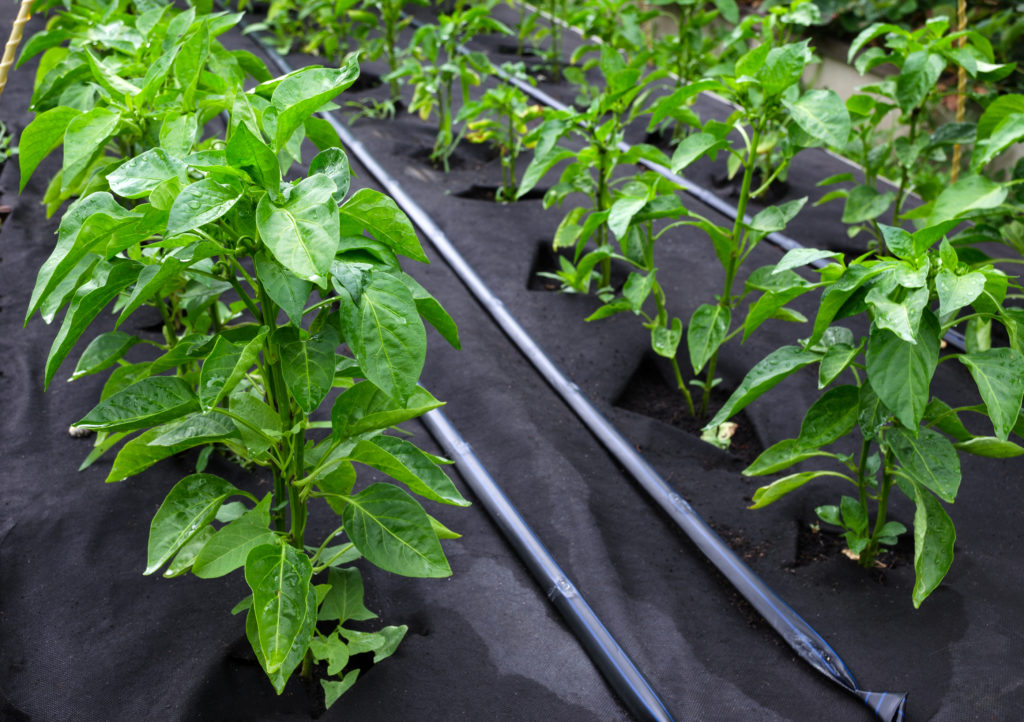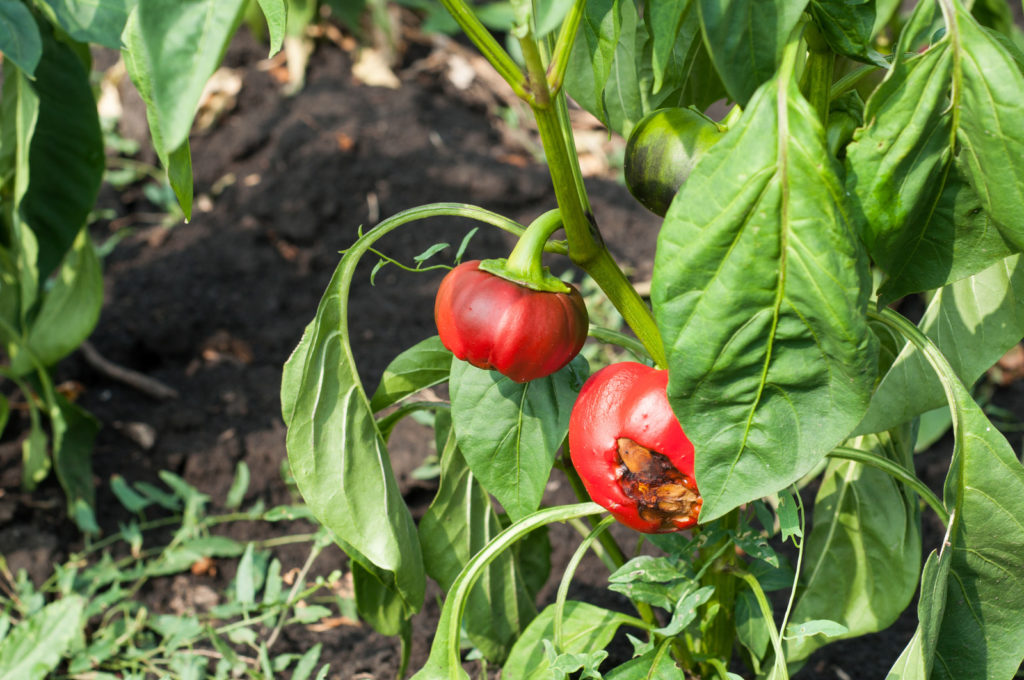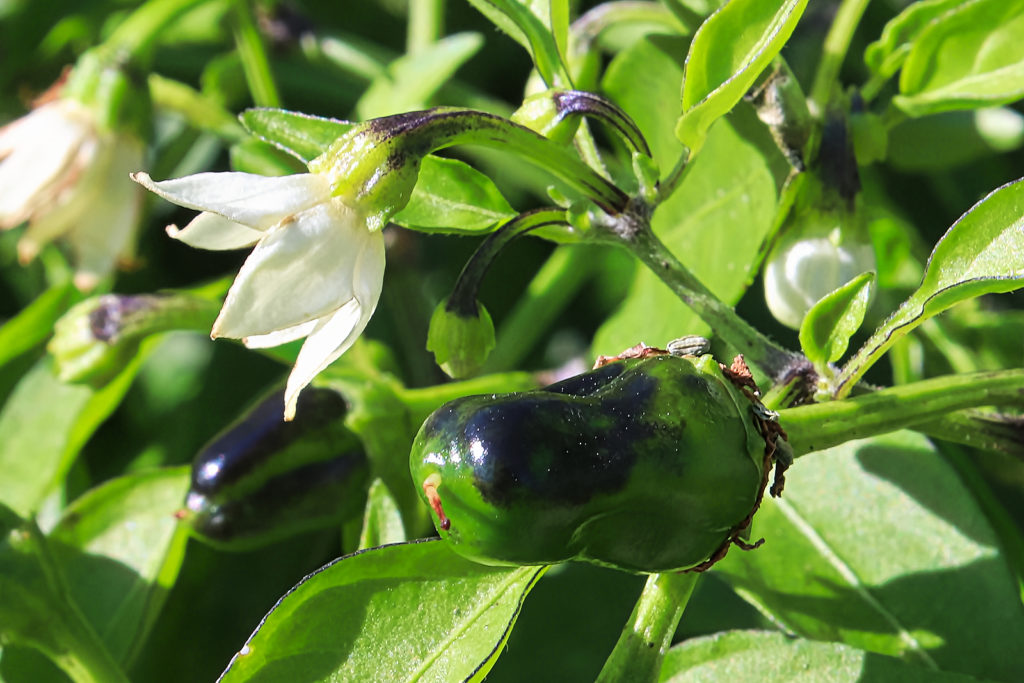Peppers–sweet peppers and hot peppers–share nearly all of the cultural and growing requirements of tomatoes.
If you can grow tomatoes, you can grow peppers.
Choose a site with full sun where the soil is moisture retentive but well-draining. If you are planting sweet peppers and hot peppers in the garden, give them some distance so they can cross-pollinate.
Best tips on How to Grow Peppers.
Here is a troubleshooting list of possible pepper problems with control and cure suggestions. (Pepper growing success tips are at the bottom of this post.)
Good Products for Pest and Disease Control at Amazon:
- Bonide Sulfur Fungicide
- Garden Safe Snail and Slug Bait
- Monterey BT Caterpillar Killer
- Neem Bliss 100-% Cold Pressed Neem Oil
- Safer Brand Insect Killing Soap
- PyGanic Botanical Insecticide

Pepper leaf problems
Leaves roll downward but there is no yellowing or stunting
Physiological leaf roll is not caused by a pathogen; it may be a reaction to temperature or weather. Keep plants evenly watered. No action is needed.
Leaves curl then become deformed and discolored; plants may be stunted
Aphids are small soft-bodied insects–green and gray–that cluster on the undersides of leaves. Aphids leave behind a sticky excrement called honeydew; black sooty mold may grow on the honeydew. Spray away aphids with a blast of water; use insecticidal soap; aluminum mulch will disorient aphids. Aphid predators include lacewing flies, ladybugs, and praying mantis.
Leaves wilt, turn yellow, then brown
Whiteflies are tiny insects that will lift up in a cloud when an infected plant is disturbed. These insects suck juices from plants and weaken them. Spray with insecticidal soap. Trap whiteflies with Tanglefoot spread on a bright yellow card.
Leaves appear wilted and scorched
Leafhoppers are green, brown, or yellow insects ⅓-inch long with wedge-shaped wings. Leafhoppers suck juices from leaves and stems. Spray with insecticidal soap or dust with diatomaceous earth.
Tiny round, shot holes in leaves; lower leaves are affected more than top ones. Flea beetles are tiny black beetles that feed on leaves and jump when disturbed. Handpick beetles and destroy them. Keep the garden free of plant debris. Cultivate the soil deeply to destroy larvae in early spring and interrupt the life cycle.
Leaves are eaten and plants are partially defoliated
Blister beetles and tomato hornworms eat leaves. Handpick insects and destroy them. Keep the garden weeds and debris. Cultivate in spring to kill larvae and interrupt the life cycle. Pick off beetles by hand. Spray or dust with Sevin or use a pyrethrum or rotenone spray.
Leaves and shoots are stripped
Colorado potato beetle is a yellow beetle ⅓ inch long with black stripes and an orange head. Handpick off beetles. Keep the garden free of debris. Spray with a mixture of basil leaves and water.
Black spots appear on leaves and lower stems; leaves turn yellow to brown
Early blight is a fungal disease spread by heavy rainfall and warm temperatures. Keep weeds down in the garden area; they harbor fungal spores. Avoid overhead watering.
Lower leaves yellow and die; the stem is discolored with brown streaks when the stem is split lengthwise; plants wilt and die.
Verticillium wilt is caused by a soilborne fungus. Plant verticillium-resistant varieties. Rotate crops and avoid planting in soil previously planted with pepper, potato, tomato, or cucumber family members.
Small yellow-green raised spots on leaves turn brown and become water soaked; leaves may fall. Bacterial leaf or fungal leaf spots cannot be cured.
Sow seeds treated for disease resistance. Prune away infected leaves. Keep the garden and tools clean. Plant disease-resistant varieties.
Leaves show dark-colored dieback from the growing tip.
Spotted wilt virus is spread by thrips. Control weeds that are host to thrips. Pinch away infected leaves or destroy infected plants.
Leaves are mottled and streaked yellow and green; leaves curl and crinkle.
Mosaic virus has no cure. It is spread by beetles. Plant tobacco mosaic virus-resistant varieties. Destroy infected plants and keep weeds down that host cucumber beetles. Wash your hands if you are a smoker.

Whole plant problems
Seedlings are cut off near the soil surface
Cutworms are gray or brown grubs that hide in the soil by day and feed at night. Handpick grubs from the soil around plants. Keep the garden free of plant debris. Place a 3-inch cardboard collar around the seedling stem and push it 1 inch into the soil.
White, frothy foam on stems
Spittlebugs are green insects that can be found beneath the foam. Handpick and destroy. They do not cause significant damage and can be tolerated.
Green insects
There are many green insects. If you see leaf damage or sticky residue on the leaves, remove the insects with a strong spray of water.
Galls or knots on plant roots; plants wilt in dry weather; plants become stunted.
Root-knot nematodes are nearly microscopic, translucent worms that inject toxins and bacteria into plant roots. Plant disease-resistant varieties. Feed plants with fish emulsion which seems to counter nematode toxins. Rotate crops. Companion plant with marigolds.
Plants do not grow; blossoms drop off; fruit does not develop.
Temperatures are too cold. Plant when the weather is warmer. Plant varieties recommended for your region.
Plants have lush foliage do not fruit or have little fruit.
The soil may be nitrogen-rich and lack phosphorus. Add aged compost to the planting bed before planting and side-dress plants with aged compost. If night temperatures are cool place a wire cage around the peppers and drape the cage with plastic at night. Increase pollination and fruit production by lightly tapping plants to make sure pollen is distributed.

Flower problems
Blossoms fall without producing fruit.
Pepper blossoms may fall if the temperature drops much below 60°F or rises above 75°F. Plant early varieties or varieties recommended for your region. Plant in warmer weather.
The plant produces few blossoms and few fruits.
Peppers that bloom while still young and also set fruit can become stunted and remain stunted all their life. Pick off flowers that develop when plants are still small. Don’t purchase seedlings that have started to bloom.
Buds and blossoms have holes; young fruits may have holes or drop; mature fruit can become misshapen and blotchy.
Pepper weevils are dark beetles ⅛ inch long; the larvae are white, legless, and found inside the fruit. Handpick weevils and grubs. Nightshade plants host the pepper weevil; destroy infested plants after harvest. Cultivate the soil to interrupt the pest’s life cycle.

Fruit problems
Fruit is normal-colored but small and flattened; there are few or no seeds inside.
Pollination was poor or incomplete. Plant when the weather has warmed and insects are active. Attract bees and other pollinators to the garden. Increase pollination and fruit production by lightly tapping plants to make sure pollen is distributed.
Sunken, water-soaked spots develop on the blossom end of the fruit; spots can turn black and mold may appear; patches may appear leathery.
Blossom end rot is caused by irregular watering or the irregular uptake of water by plants; this can happen when temperatures rise above 90°F. Keep soil evenly moist; mulch around plants. The soil may have a calcium imbalance that inhibits the uptake of water; add limestone to the soil if the pH is below 6.0.
Sunken water-soaked areas on fruit and stems; fruit may become watery and collapse.
Anthracnose is a fungus disease that overwinters in infected seeds and the soil. Destroy rotting fruit; keep fruit off the soil. Spray or dust with a fixed copper- or sulfur-based fungicide every 7 days. Do not collect infected seeds.
Fruit has worms or wormholes.
Corn earworm is a white, green, or red caterpillar with spines of about 1½ inches long. The tomato hornworm is a green caterpillar 3 to 5 inches long with white stripes. These pests will eat holes in leaves and fruit. Handpick and destroy. Spray with Bacillus thuringiensis. Spray with pyrethrum or rotenone.
Fruit has light-colored areas that are soft and become sunken and dry.
Sunscald can affect peppers exposed to the too hot sun. Prune plants so that blossoms and fruits have a leaf canopy above. Control leaf spot that causes leaves to drop. Use shade-cloth or a lath screen to shade peppers during intense hot spells.
White spots on fruit; leaf tips are distorted.
Thrips are tiny insects, yellow, brown, or black with fringed wings. They scrape plant tissue as they feed leaving a scar. Keep the garden free of weeds. Spray with insecticidal soap or sprinkle diatomaceous earth on leaves.
Pepper growing success tips
Planting
Peppers require full sun for the best harvest. Plant peppers in well-drained soil rich in organic matter. Use 6-inch raised beds if your soil is poor and does not drain well. Add aged compost and bonemeal to each planting hole.
Planting time
Peppers require a planting soil temperature of 65°F or greater. Get a jump on the growing season by starting peppers indoors for 8 to 10 weeks before transplanting them into the garden.
Care
Consistent, even moisture is important for pepper growth. Only when peppers are near harvest as they finish ripening should you cut back on watering. Peppers are heavy feeders. Add alfalfa, cottonseed, or fish meal to planting beds before planting. Side dress peppers with aged compost or bloodmeal (about 2 tablespoons per plant) when fruits start to form. Keep peppers well-supported once fruit sets–use a small tomato cage or stakes. Keep peppers upright so that leaves protect fruits below from sunscald.
Harvest
Sweet bell peppers can be harvested when they start to turn color; they can finish ripening indoors on the kitchen counter. Hot peppers can be picked as you need them. Pick all peppers before the first frost.
Pepper articles at Harvest to Table:
How to Grow Sweet Bell Peppers
How to Plant and Grow Hot Chili Peppers
Six Tips to Grow Peppers for Flavor
7 Tips for Growing Peppers in Pots
How to Harvest and Store Peppers
Five Ways to Cook and Serve Sweet Peppers
Five Ways to Cook and Serve Chili Peppers
Beginner’s Guide to Canning Peppers
Pepper Growing Problems Troubleshooting
Mid-Season Pepper Problem Cures
Epsom Salt, Milk, and Organic Fertilizers for Tomatoes and Peppers
How to Prevent Blossom Drop — Tomatoes and Peppers
Vegetable Garden Organic Weed Control
Vegetable Garden Organic Pest Control
Garden Planning Books at Amazon:
- Vegetable Garden Almanac & Planner
- Kitchen Garden Grower’s Guide Vegetable Encyclopedia
- Vegetable Garden Grower’s Guide
- Tomato Grower’s Answer Book















